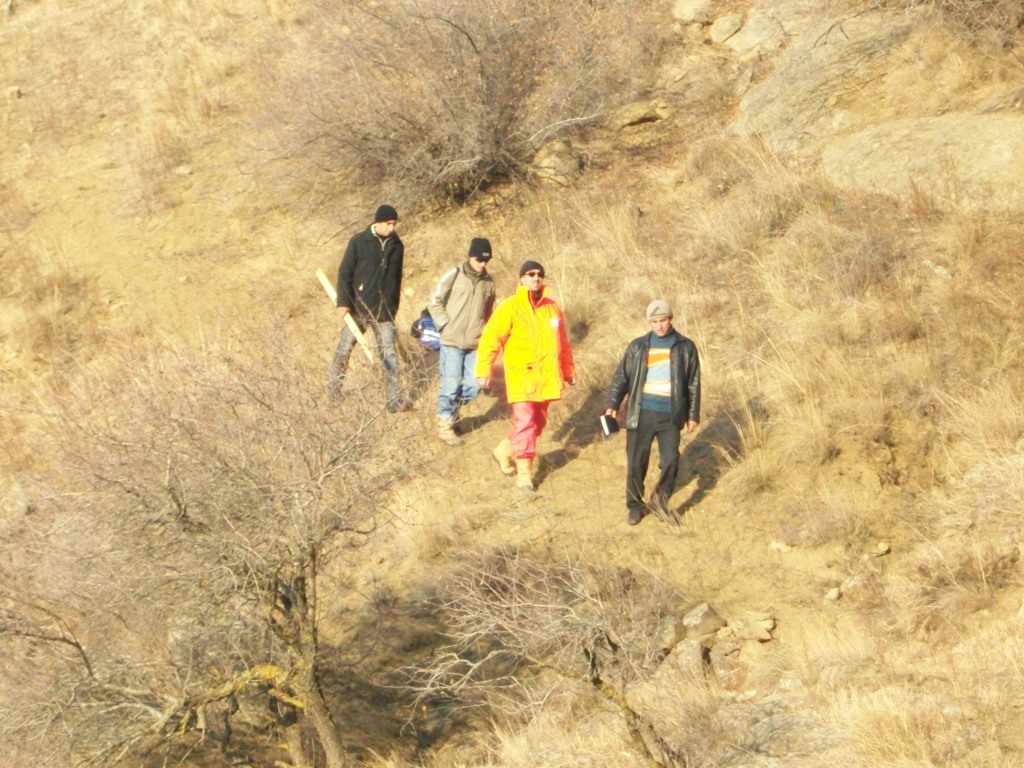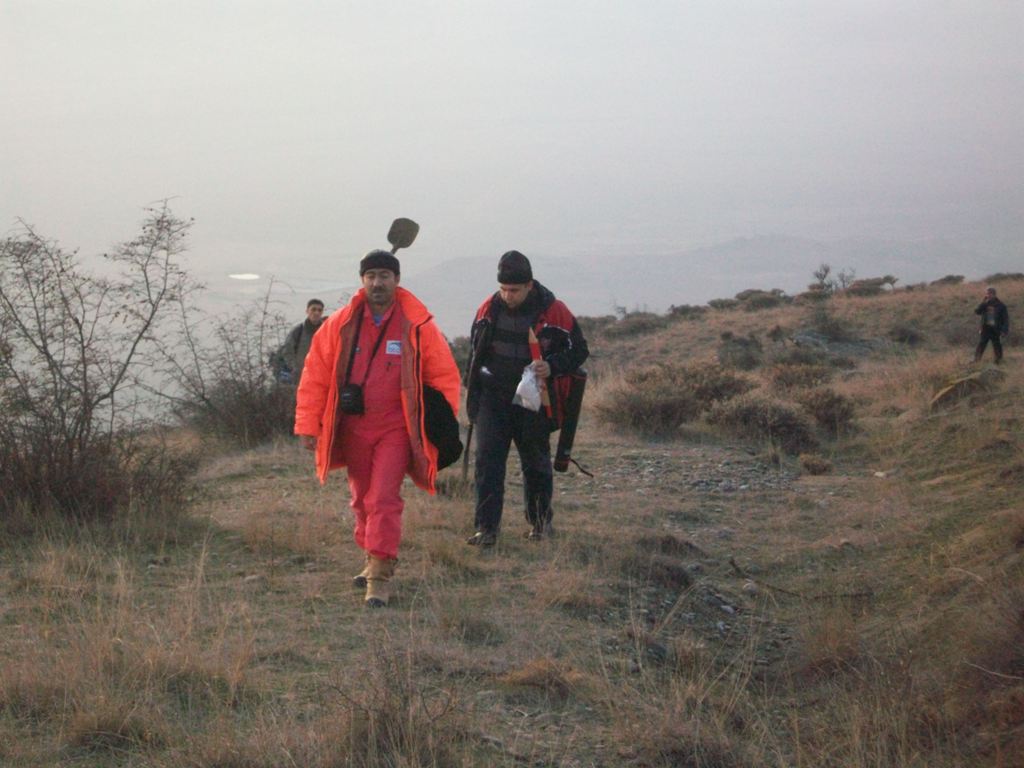According to the letter number 3171/09, dated 25.11.2008 on “Investigation of graves discovered by chance in “Keshikchidagh” state historical and cultural reserve” of the Minister of Culture and Tourism Abulfas Garayev sent to the president of Azerbaijan National Academy of Sciences Mahmud Karimov, following expedition members of ANAS Institute of Archaeology and Ethnography have been sent to Aghstafa District on Decemeber 7, 2008:
Najaf Museyibli – chief of the expedition, deputy director on scientific affairs, archaeologist, candidate of historical sciences
Dmitri Kirichenko – anthropologist, candidate of historical sciences
Anar Aghalarzade – archaeologist, scientific worker
We want to express our gratitude for all necessary facilities offered by the head of the reserve Musa Mursaguliyev.
Reserve is monastery complex consisting of excavated caves in the Middle Ages in the sand stone precipices located in the south and south-eastern side of the mountains, in Jeyranchol, in the area near to the Georgian border. Three graves (Figure 3-4) were found in cave No. 19 (Figure 2) while reserve personnel were doing cleaning and renovation in one of the areas of caves (Figure 1) in reserve. Inside of the cave is almost square-shaped: 5,5 m x 5,1 m. The maximum height from floor up to ceiling is 3.2 m.
The graves cover the north and the west parts of the cave. They are dug in the sand stone floor accurately. The upper and the lower ends of graves are expanded to the sides in the shape of stairs. By putting large stone slab to the lower stair, the top of the graves were closed in the same level of the surface of the cave. All grave chambers were in the direction of North-west-South-east (Figure 3-4).
In two graves – grave No. 1 and No. 2 humans were buried. The graves were used as tombs (sardaba (tomb)-grave where few or more number of people is buried). Inside of chamber of the grave No. 3 was cleaned of wild bird manure and some fine grained soil. It was determined that it is completely empty and nobody was buried here. Besides grave No. 3 close to the entry of the cave outline of grave with 6-7 cm depth and 10sm width was canal was dug. However, the work of digging the grave chamber was not completed here. It seems that cave No. 19 was used as burial place of the Christian saints instead of monastery complex. Discovery of graves in the caves of areas of the reserve complex is not exception.
The graves are numbered conditionally according to the sequence of their excavation (Figure 5-6).
The grave No. 1 is revealed next to the wall opposite to the cave entry door. One side of the chamber is narrower than another side.
The skeleton of three human beings was found on the floor of the chamber while cleaning it of fine soil. Bones are mixed and their order has been violated. Skull bones have been found along with each other in the north-west part of the grave chamber. They were buried in different periods of time. In the burial of the next corpse remains of previous human were moved near to the wall of chamber. Therefore the bones inside grave are mixed and their order is violated. After cleaning bones from soil the top of the grave chamber was closed by stone slab.
Measures of the grave: length – 195 centimetre
Width – north-west -95 centimetre, south-east – 80 centimetre
Width of upper step shaped part -10 centimetre, height – 25 centimetre
Depth of the grave – 135 centimetre
The grave No. 2 is in the north-west of the first one and covers the northern corner of the cave. Inside of the grave was filled with fine soil mixed with wild bird manure. It was determined that there were bones mixed with each other in the floor of the grave belonging to a two human being. Skulls were found in the north-west part of the garve side by side. Size of skulls could not be measure as they were destructed. Later the bones were cover by soil.
Measures of the grave: length – 195 centimetre
Width – 97 centimetre
Width of upper step shaped part – 5-13 centimetre
Height – 30 centimetre
Depth of the grave – 120 centimetre
The grave No. 3 was dug parallel to the grave No. 2. It was completely cleaned and determined that no burial act was observed in it.
Measures: length – 2 metre
Width – 87 centimetre
Width of the ends of upper step shaped part – 5 centimetre, Width of the sides of upper step shaped part – 33 centimetre
Height – 30 centimetre
Depth of the grave – 155 centimetre
The graves belongs to the Middle Ages. It is difficult to express any idea about their exact age. No archaeological materials were found in the graves. Just in the grave No. 1 flat river stone was found at the depth of 40sm while cleaning it from soil. There were signs of trimming on the sides of the stone. Such trimmed stones were found in monuments of different stages of the history. There is no information about the time and circumstance of placement of stone to the grave. Two pieces of bone was taken from the grave for the radiocarbon analysis. Only after this analysis it is possible to determine the exact age of the graves.
As mentioned above well-kept three skulls were found in the grave No. 1. It was possible only in these skulls to measure the size and determine their anthropological type.
Skull No. 1 (Figure 7-8) is brachycephalic skull (round, broad headed). Its face is dimpled up-down and broad. Steep nose with medium-sized width. The backward of the head is flat. Fovea is deep and wide. It belongs to the anthropolgy type of Iberia with Europoid origin reflecting the half-breed of Caucasian and Anatolian anthropological types. It is distinctive for the Georgian people of the Eastern Georgia. The anthropological type of Iberia first was determined by Georgian anthropologist M. G. Abdushelishvili in the 60s of the 20th century.
Skull No. 2 (Figure 9-10) is brachycephalic skull. Its face is broad and flat. Its nose is with the average size of height and width. Fovea is not so deep, but is broad. It is of Europoid origin and reflects half-breed features of Caucasian and Caspian types. This type can be seen both in Georgian and Azerbaijani population.
Skull No. 3. (Figure 11-12) is dolichocephalic skull (long head). It has face with average height and width. It has thin nose with medium height. The fovea has average depth and is not so broad. It belongs to the Caspian type of Europoid origin. This type can be observed in the territory of Azerbaijan in all the historical stages since the Mesolithic period.
The measurement data of the human skull found in “Keshikchidagh” is given in the table below: ..
|
N |
Indications |
Skull N1 |
Skull N2 |
Skull N3 |
|
1 |
Length |
165 |
177 |
187 |
|
8 |
Width |
142 |
144 |
137 |
|
17 |
Height |
126 |
134 |
134 |
|
8:1 |
Skull indications |
86 |
81,4 |
73,3 |
|
45 |
Width of face |
143 |
139 |
132 |
|
48 |
Height of face |
64 |
65 |
73 |
|
51 |
Width of eye cavity |
44 |
44 |
39 |
|
52 |
Height of eye cavity |
36 |
33 |
34 |
|
54 |
Width of nose |
25 |
26 |
24 |
|
55 |
Height of nose |
55 |
52 |
53 |
In connection with the spread of Islam in the South Caucasus region, a small part of the Albanian population living in the borderland with Georgia were affected by the Georgian Christianity and were subject to a gradual assimilation. Revealing of skulls of both Georgians and Azerbaijanis in the grave No. 1 in “Keshikchidagh” reserve can be explained by these historical events. The skull No. 2 and No. 3 belong to Georgianized Albanians assimilated in the Middle Ages.
Taking these facts we consider appropriate the presentation of “Keshikchidagh” Reserve as a symbol of Azerbaijani-Georgian friendship and cultural relations.
Chief of expedition: N.A.Museyibl





